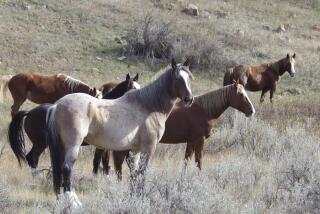Park Service Will Round Up Wild Horses to Thin Herd
- Share via
FARGO, N.D. — Dozens of wild horses that some assert are descended from Sitting Bull’s war ponies are to be captured this fall at Theodore Roosevelt National Park in western North Dakota.
Chief ranger Bob Powell says the wild horse population is nearing 120, and he hopes that the Oct. 1 roundup will reduce the herd by at least 75 animals.
“If we didn’t remove some of the horses, they would start to compete with the park’s bison, elk and bighorn sheep,” Powell said. “A piece of land will only grow so much wheat, support so many gophers and provide for so many horses. When that number is exceeded, nature takes over and does the reducing for you.”
It will take two helicopters and 10 cowboys several days to complete the roundup. “It all depends how lucky we are in corralling them,” he said.
The horses will be driven into an area where two 7-foot-high wire fences form a mile-long funnel. Gates at the narrow end of the funnel lead to a corral, holding pasture and pens where the animals will be sorted, culled and loaded into trucks.
Powell says the horses removed from the herd will be sold at auction. The rest will be freed to roam the 40,000 acres in the southern section of the park.
A Park Service study completed in 1989 said feral or wild horses were driven into the North Dakota Badlands by Indians in the 18th and 19th centuries.
Observers in the 1840s noted Spanish characteristics in the horses of the nearby Arikara tribe. But to artist Frederic Remington, they had a look of their own.
“He is not beautiful,” wrote Remington in the 1880s. “His head and neck join like the two parts of a hammer . . . his quarters are apt to run suddenly back from the hips, and the rear view is decidedly mulish about the hocks.”
The horses were widely praised for their hardiness and disposition. The Marquis de Mores, a French aristocrat turned frontier cattleman, favored Indian ponies above all others. In 1883, he bought 250 Sioux mares confiscated from Sitting Bull upon the Indian chief’s surrender.
De Mores had a hard time keeping track of the horses and had troubles with horse thieves. There were only 60 mares left when he sold his stock to a local rancher two years later.
Whether de Mores’ horses are the foundation of the park herd is open to question.
Medora cattleman Tom Tescher, who has kept track of the herd since the early 1940s, believes that they are descended from domestic livestock.
“During the Depression and drought, so many people moved out of this country and just left their horses,” Tescher said.
But ranchers Leo and Frank Kuntz are convinced of the horses’ historic origins.
Leo Kuntz finds some biological basis for that view, notably a fused backbone characteristic of the mustang, or Indian horse.
“These horses really do look different, almost like Remington described them,” he said. “They’ve got a square build, are heavily muscled and generally roan in color, either blue roans, red roans, black or gray.”
More to Read
Sign up for Essential California
The most important California stories and recommendations in your inbox every morning.
You may occasionally receive promotional content from the Los Angeles Times.












